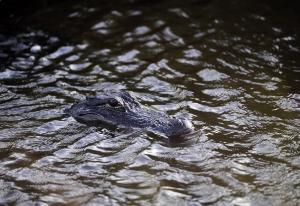June 22 (UPI) — Alligators are ending up inside suburban garages and backyard pools. They’re blocking sidewalks, basking in driveways and interrupting professional golfers.
Gator experts say the reptiles are just looking for mates.
“They’re very promiscuous animals,” Kimberly Andrews, a herpetologist and researcher at the University of Georgia’s Odum School of Ecology, told UPI.
Throughout the Southeast, mating season is coming to a close. Females are gathering pine needles, leaves and soil to build their nests. But there are still some males looking for another chance to sire offspring.
Each female lays 20 to 40 eggs. The clutch of eggs can yield offspring sired by multiple fathers. And males can father offspring with multiple females. This promiscuity helps ensure genetic diversity among gator populations.
“Males literally go around from female to female, so they’re moving around a lot,” Andrews said.
As a result of this activity, an increase in gator-human interactions occurs nearly every spring and summer.
“It’s a matter of probability, humans are everywhere,” Andrews said. “And during mating seaons, gators are more places.”
Despite the news of gators ending up in odd places, researchers say gators aren’t actually attracted to humans or their environs.
“Alligators move around more during mating season, which can contribute to their visibility, but there is no behavioral change toward people,” Tammy Sapp, communications manager with the Florida Fish and Wildlife Conservation Commission, told UPI.
As temperatures rise, an alligator’s metabolism kicks into gear, which means the reptiles are more likely to be looking for prey and mates during the spring and summer. But both prey and mates are found near water, not in garages or on sidewalks.
Andrews says gators only travel over land out of necessity. And when they set out to find new territory and new females, they’re going to gravitate toward bodies of water.
“If there is fresh water there, the alligators are going to find a way to get to it,” Andrews said.
In fact, scientists believe there is some sort of biological mechanism that allows gators to find freshwater — a mechanism biologists don’t quite understand.
Studies show alligators will tend to travel along watery routes, through lagoons and swamps, to get from place to place, before they’ll trek through the forests, or worse yet, across a suburban road.
Golf courses with water hazards in the Southeast are often inhabited by alligators. And these golf course are often situated within residential communities. If the pockets of freshwater are closer together and well-connected, residents will be less likely to see gators moving across land — through backyards, for example.
“The more sparse or broadly distributed the water, the more likely it’s going to be for alligator movement over land,” Andrews said.
Gators are inherently wary of people, and they actually move differently — they deploy a different gait — when moving through human environs.
Andrews says she enjoys working with property managers and real estate developers to ensure a peaceful coexistence between residents and gators. Historically, complaints have led to gator removal. But Andrews say that’s only a temporary fix — and not a good one. Gators will eventually find their way back to the water.
In addition to ensuring gators have the ability to move from freshwater body to freshwater body without crossing roads and yards, Andrews says it’s important to educate people on how to behave around gators.
“When they’re fed, they become the dog at the dinner table and you only have to do it once,” Andrews said. “That can lead to serious management issue when they learn bad behaviors on picnic day.”
Teaching humans how to interact with wildlife — keep your distance, don’t disturb — is the best way to reduce and avoid conflicts with wild animals, she said.
“Practicing wise and sustainable behaviors is important for the safety of inhabiting and visiting people and for the long-term sustainability of wildlife populations,” Andrew said.
And healthy wildlife populations make for more enjoyable outdoor experiences for people.

COMMENTS
Please let us know if you're having issues with commenting.